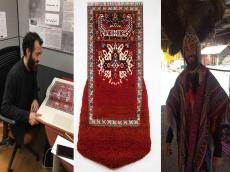|
|
TODAY.AZ / Arts & Entertainment
Exhibition of national artist to open in Washington
04 October 2018 [14:32] - TODAY.AZ

By Azernews
By Laman Ismayilova
A personal exhibition by Faig Ahmed entitled "Nonvisual Language" will open at the Museum of Textiles at George Washington University on October 6.
The exhibition will feature new works on which the artist worked after returning from Peru.
The preparation for the exhibition began about a year ago. As part of his research activities, Faig Ahmed went to Peru for the first time. After examining the collections of Peruvian textiles, as well as the texts, objects and embroideries of the Shipibo-Conibo tribe at the Washington Textile Museum, the artist spent a month in a remote village hidden in the thick of the Amazonian jungle in the territory of modern Peru.
One of the main goals of the trip was to get acquainted with the rich and ancient culture of the Shipibo-Conibo tribe. Faig has long been fascinated and interested patterns on fabrics and ceramics, which are fundamentally different from the patterns and familiar patterns that we see everywhere. The peculiarity of these patterns is that they are applied by shamans, who traditionally have a strong connection with nature, which the city dweller has long since and, unfortunately, lost.
This connection is realized through communication with plants and with the earth. As the Shamans themselves say, plants have consciousness, and it is much more ancient than human consciousness. And that is why people should actively learn from nature. Patterns created in the Shipibo tribe are not separated from the concept of sound or vibration.
There is even a term denoting sound and pattern as a single substance. Thus, with the creation of a new language, Shipibo tribe expanded the limits of textiles and its connection with the subconscious.
In the course of his research, Faig also relied on the work of the Azerbaijani scientist and professor Khudu Mammadov, who studied the connection of music, in particular, mugham and patterns of carpets.
Through his works, the artist shows that all techniques of ornament formation on textiles around the world are somehow similar, which is why patterns created on traditional Azerbaijani carpets and Peruvian textiles can be reduced to a single base.








URL: http://www.today.az/news/entertainment/174524.html
 Print version
Print version
Connect with us. Get latest news and updates.
See Also
- 19 December 2025 [13:12]
History Museum holds presentation of Iravan Fortress City's ethnographic map - 19 December 2025 [11:51]
Philharmonic Hall holds concert dedicated to prominent statesmen - 19 December 2025 [10:43]
Exhibition 'Color of Voice' opens at National Art Museum - 18 December 2025 [14:53]
Culture Ministry listed among winners of MilliNet 2025 competition - 18 December 2025 [13:33]
Opera 'Nasimi' to be presented in new AI-Powered stage production - 18 December 2025 [12:56]
Live-Show: Czechia through eyes of Azerbaijani artists - 17 December 2025 [13:11]
Culture Ministry, UNAOC explore new opportunities for cooperation - 17 December 2025 [11:56]
Master classes on tar and piano held in Mingachevir - 16 December 2025 [12:48]
Anthology 'Classic Czech Short Stories' in Azerbaijani presented in Prague - 16 December 2025 [12:27]
Azerbaijani tenor shines at London’s Royal Opera House
Most Popular
 President Erdo?an addresses global order, regional stability at 16th Ambassadors Conference
President Erdo?an addresses global order, regional stability at 16th Ambassadors Conference
 Pashinyan calls for restoration of railway links as Azerbaijani fuel shipment heads to Armenia
Pashinyan calls for restoration of railway links as Azerbaijani fuel shipment heads to Armenia
 Cotton cultivation boom links tradition with modern value-chain growth
Cotton cultivation boom links tradition with modern value-chain growth
 Azerbaijan, Netherlands highlight positive momentum in political relations
Azerbaijan, Netherlands highlight positive momentum in political relations
 President Ilham Aliyev meets with President of United Arab Emirates in Abu Dhabi
President Ilham Aliyev meets with President of United Arab Emirates in Abu Dhabi
 Prosecutor demands life imprisonment for accused war criminal
Prosecutor demands life imprisonment for accused war criminal
 Diplomacy World magazine releases special issue highlighting COP29 legacy
Diplomacy World magazine releases special issue highlighting COP29 legacy
